Railroad Signals: Providing Safety And Efficiency
Last revised: September 4, 2024
By: Adam Burns
Railroad signals are an integral part of railroading, without them there is absolutely no way trains could safely operate, particularly on single track lines.
However, more than just for safety signals allow for the efficient and steady flow of trains, enabling several to operate over a single-tracked line.
Signals have their beginnings dating back to the industry's infancy itself with the famed ball-type signal.
Perhaps, though, the most famous signal-type of all was the semaphore, which came into use in the mid-19th century and even today can still be found in regular service!
While signal displays and meanings often varied from railroad to railroad some of the most common types were the color-light signals (or tri-lights), searchlights, position-lights, and color-position lights with the tri-light the most popular today.
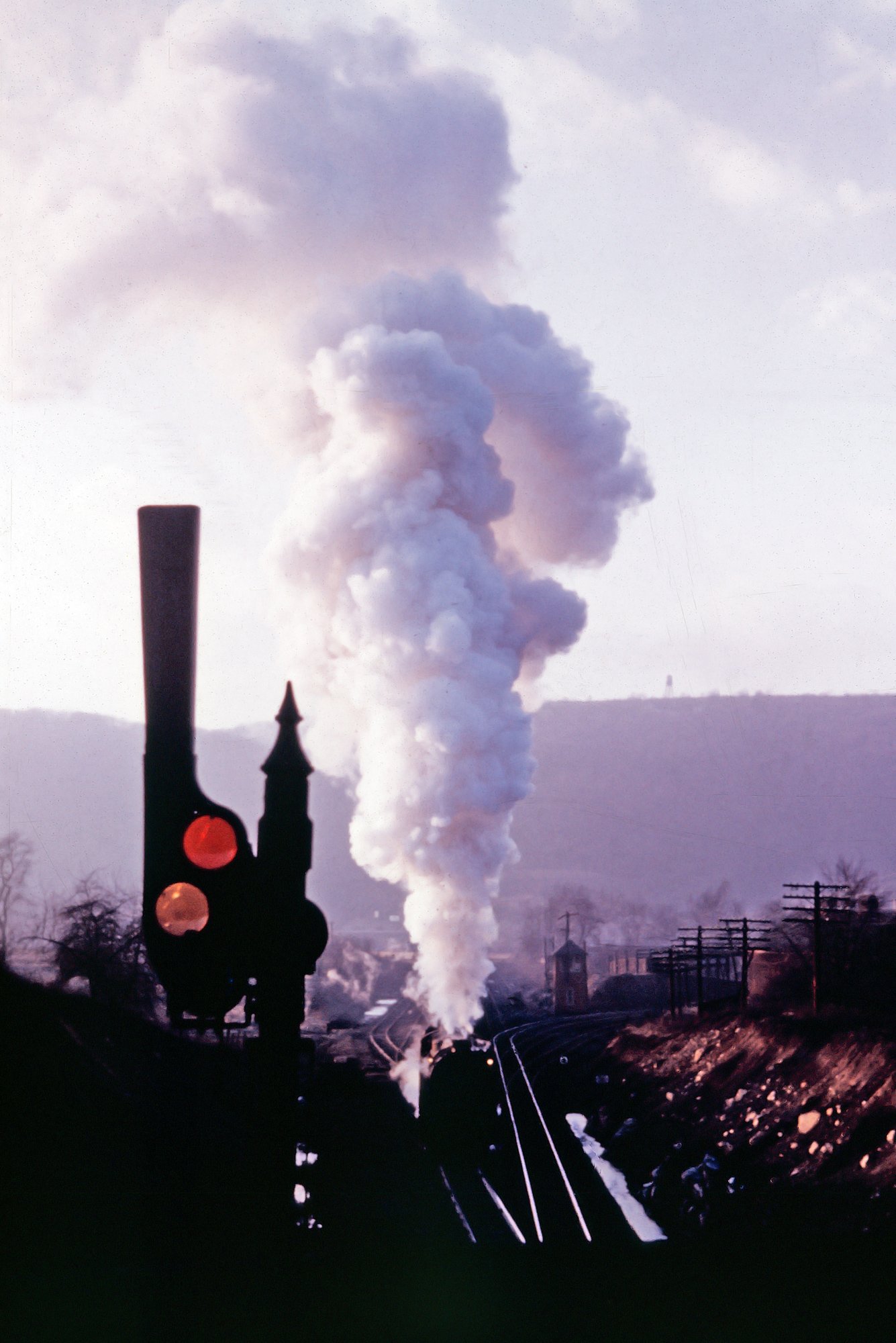 A semaphore protects the Western Maryland main line at Maryland Junction as an eastbound freight departs Ridgely, West Virginia, circa 1950. The train is about to enter Knobley Tunnel while MY Tower can be seen in the background. The line straight ahead, behind the train, heads for Knobmount Yard and Elkins while the tracks diverging to the right are bound for Connellsville. A.C. Kalmbach photo. American-Rails.com collection.
A semaphore protects the Western Maryland main line at Maryland Junction as an eastbound freight departs Ridgely, West Virginia, circa 1950. The train is about to enter Knobley Tunnel while MY Tower can be seen in the background. The line straight ahead, behind the train, heads for Knobmount Yard and Elkins while the tracks diverging to the right are bound for Connellsville. A.C. Kalmbach photo. American-Rails.com collection.The first railroad signals came into use in 1832 on the New Castle & Frenchtown Railroad but really came of age in 1872 with the invention of the track circuit by William Robinson.
This circuitry allowed for the steel rail's natural conductivity to be employed thus giving birth to automatic block signaling systems, the leader of which remains Union Switch & Signal created by George Westinghouse in 1881.
Today US&S is part of Ansaldo STS, an Italian company. The NC&F's original signaling system, way before electricity itself, used a ball (hence its name, the ball-type) that operated on a vertical pole and pulley system with the high, center and low position displaying various means (with the ball itself also usually both black and white coloring).
If the ball was high this was a clear-to-proceed display giving way to the now common railroad term "highball". Naturally, a the ball system required an operator at each location thus proving to be a rather expensive operation.
Semaphores
The first electrified railroad signaling system was the semaphore . When the semaphore came into use in the 1860s it was still an unpowered system.
Basically the semaphore worked on a blade system whereby the indication was dependent on the position of the blade.
During the semaphore's infancy having proper sight of the signal during the nighttime hours proved, obviously to be a problem so later versions were equipped with red, yellow and green lenses so that railroad engineers could clearly see the indication being given.
The earliest semaphores known as lower-quadrant semaphores operated below the horizontal position with a downward-vertical blade (on about a 60 degree radius) meant proceed while a horizontal blade meant stop.
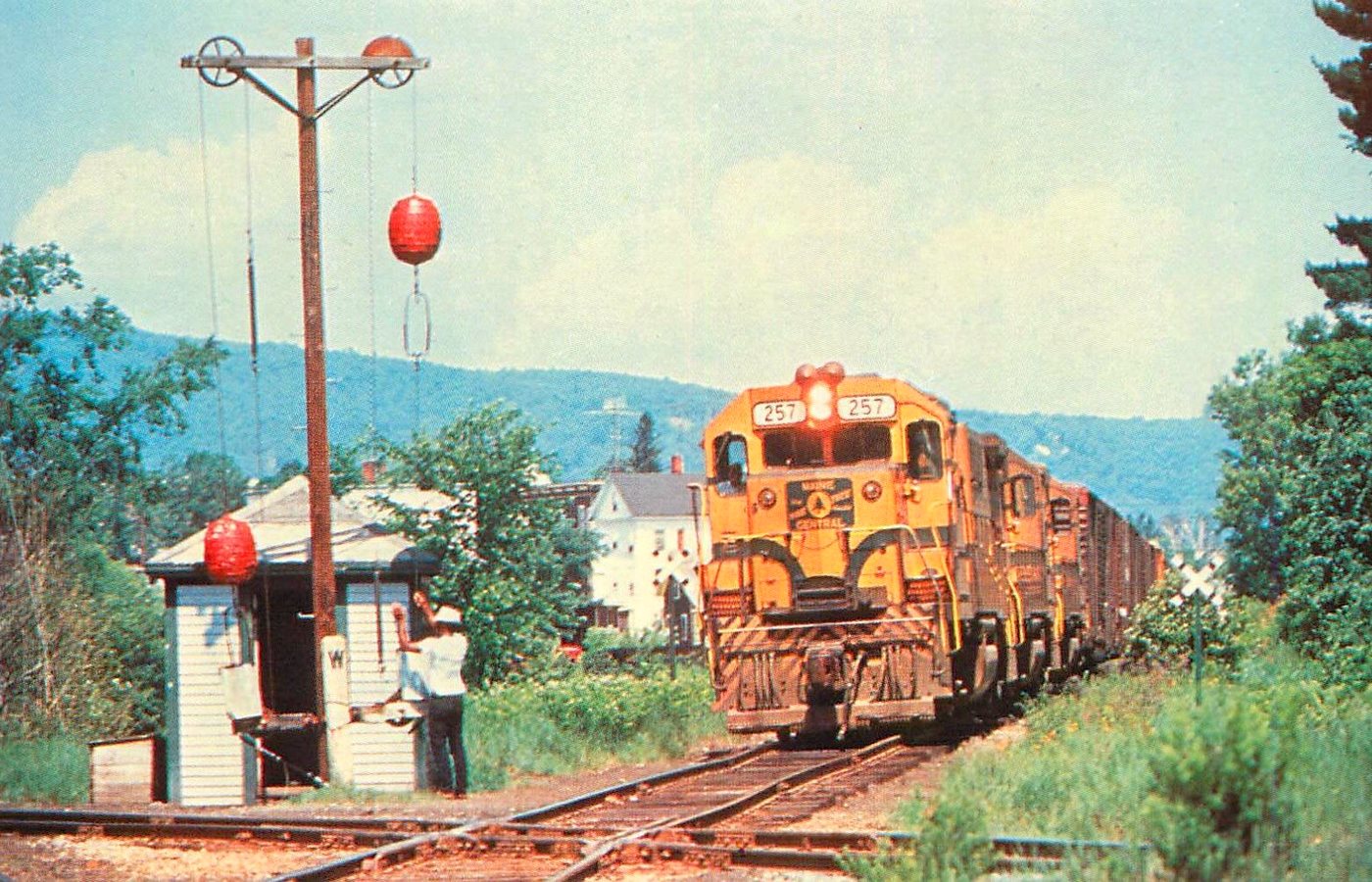 Maine Central GP38 #257 is ahead of freight 1/R-1 as it waits to cross the Boston & Maine diamond at Whitefield, New Hampshire protected by the last active set of ball signals (where the term "High Ball" originated) during the 1970s. Ronald Johnson photo.
Maine Central GP38 #257 is ahead of freight 1/R-1 as it waits to cross the Boston & Maine diamond at Whitefield, New Hampshire protected by the last active set of ball signals (where the term "High Ball" originated) during the 1970s. Ronald Johnson photo.The most common semaphore type was the three-position, upper-quadrant signal that was introduced around the beginning of the 20th century.
It operated above the horizontal position with an upward-vertical blade meaning proceed, horizontal blade meaning stop, and a 45-degree position meaning caution.
This type of semaphore can amazing still be found in use today, over 100 years since it became the standard semaphore type in 1908 (although be sure and get your photos of these structures while you can, many railroads are rapidly replacing them).
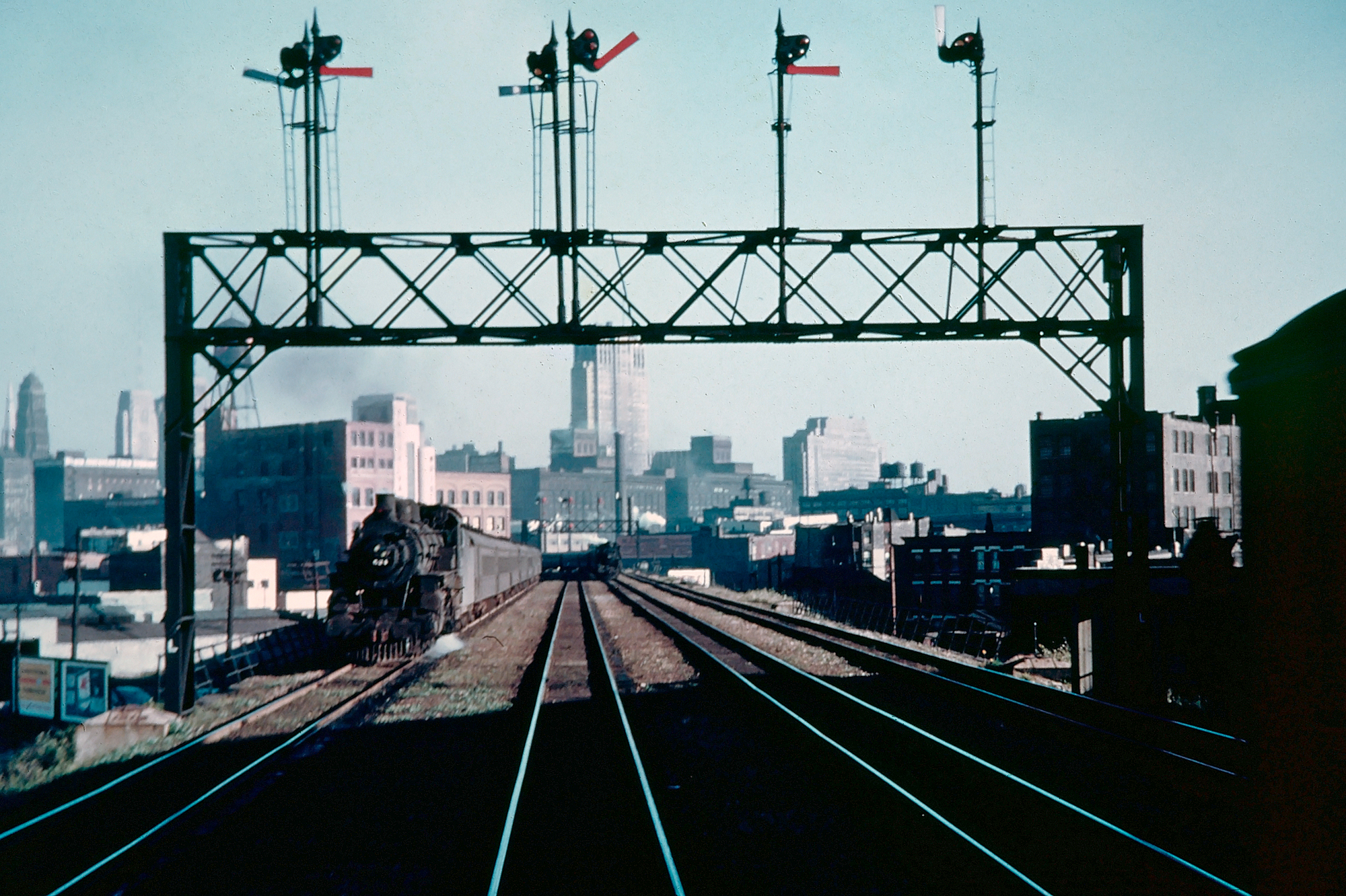 Semaphore blades protect the approach to C&NW's Northwestern Terminal in Chicago, circa 1953. Even by this date, semaphores were an antiquated technology although still widely employed across the country. A.C. Kalmbach photo. American-Rails.com collection.
Semaphore blades protect the approach to C&NW's Northwestern Terminal in Chicago, circa 1953. Even by this date, semaphores were an antiquated technology although still widely employed across the country. A.C. Kalmbach photo. American-Rails.com collection.Position-Light Signals
Position-lights were the chosen railroad signals for use on the Pennsylvania Railroad and Norfolk & Western Railway.
The system used a standard yellow light usually with three lights arranged in a semicircle to the upper right and three to the lower left with one in the center.
Depending on what type of indication the three-aligned lenses were giving (i.e., vertical, horizontal or diagonal) the train would either proceed, stop or some other cautionary measure (such as stop and proceed).
Position-light signals can still be found on former PRR and N&W routes by current owner Norfolk Southern is slowly replacing them with the redundant tri-light for easier maintenance.
Searchlight Signals
The searchlight would become one of the most popular railroad signals during the classic era of the 20th century.
It was introduced in 1920 and used only one lamp that displayed a green, yellow and red indication by way of rotating color lenses.
found use on dozens of classic railroads such as the Rock Island, Union Pacific and Atlantic Coast Line but the high amount of maintenance required to keep the colored lens system functioning caused it to fall out of favor for the much easier maintained tri-light signal.
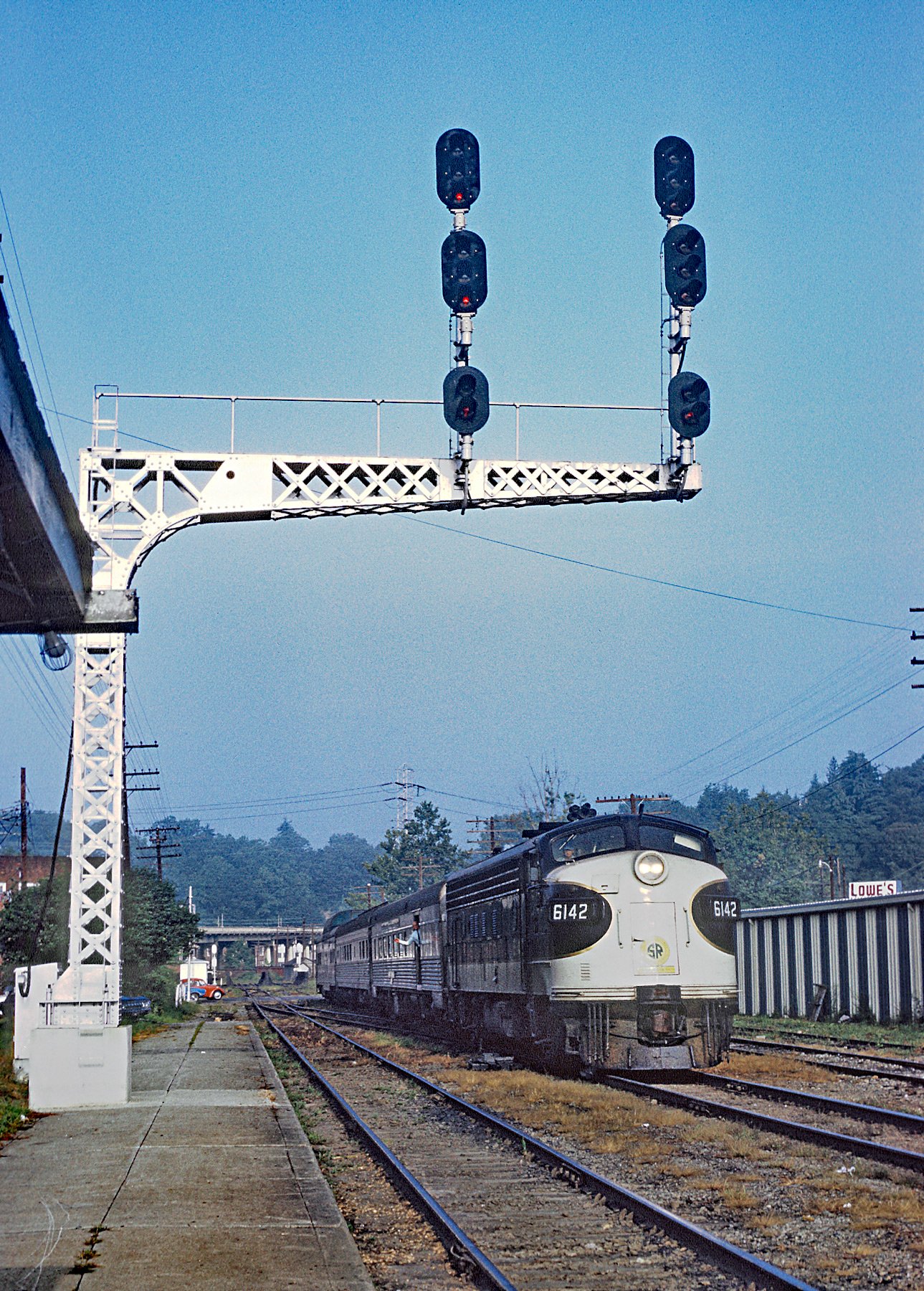 A classic Southern Railway cantilevered signal protects the small freight yard at the Biltmore Station near Asheville, North Carolina in August, 1971. Pictured is the eastbound "Asheville Special." The line nearest the photographer heads to Spartanburg, North Carolina which contained the torturous Saluda Grade. Roger Puta photo.
A classic Southern Railway cantilevered signal protects the small freight yard at the Biltmore Station near Asheville, North Carolina in August, 1971. Pictured is the eastbound "Asheville Special." The line nearest the photographer heads to Spartanburg, North Carolina which contained the torturous Saluda Grade. Roger Puta photo.Color Position-Light Railroad Signals (CPLs)
Color position-light signals, or CPLs, are virtually synonymous with the Baltimore & Ohio Railroad.
The B&O's is a simplified version of the PRR position-light in that it has no center lens but essentially functions in the same way as the PRR version save that it uses different colors to project its meaning and not the standard yellow.
For instance, two vertical green lens is a clear and proceed indication whereby a yellow diagonal indicates caution and a red horizontal means restricted (stop).
The B&O also used a white light above the signal for further instructions (sometimes cantilevered).
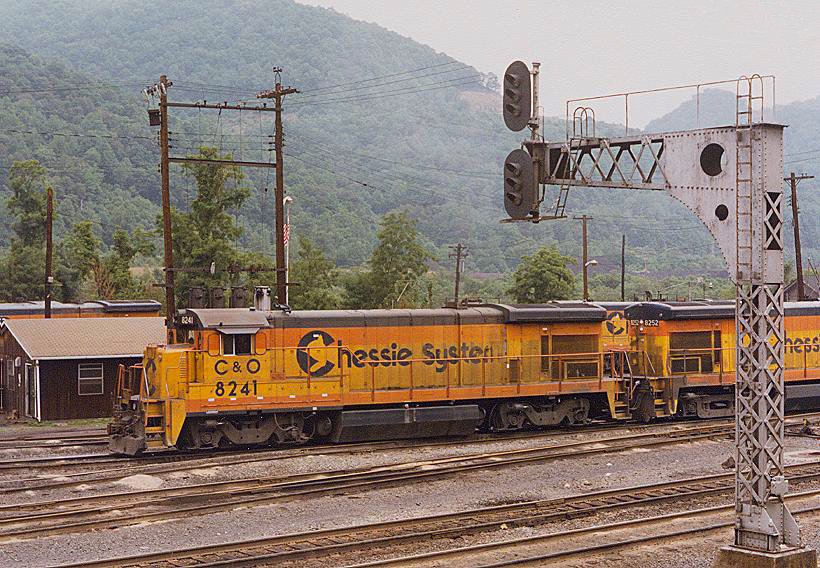 Chessie System/C&O B30-7 #8241 and #825 roll past the unique Chesapeake & Ohio cantilever signals protecting the main line at Handley, West Virginia on May 29, 1982. Doug Kroll photo.
Chessie System/C&O B30-7 #8241 and #825 roll past the unique Chesapeake & Ohio cantilever signals protecting the main line at Handley, West Virginia on May 29, 1982. Doug Kroll photo.Color-Light Signals
Color-light signals came into use around 1914 and are essentially an inverted highway stoplight with green above (proceed), centered-yellow (caution) and restricted below.
However, other versions of this railroad signal include the triangle design, which operates basically in the same fashion just with a different layout.
Also known as tri-lights they are, today, the favorite among Class I railroads with lines like CSX and Norfolk Southern Railway replacing their historic B&O and PRR versions with color-lights for ease of maintenance.
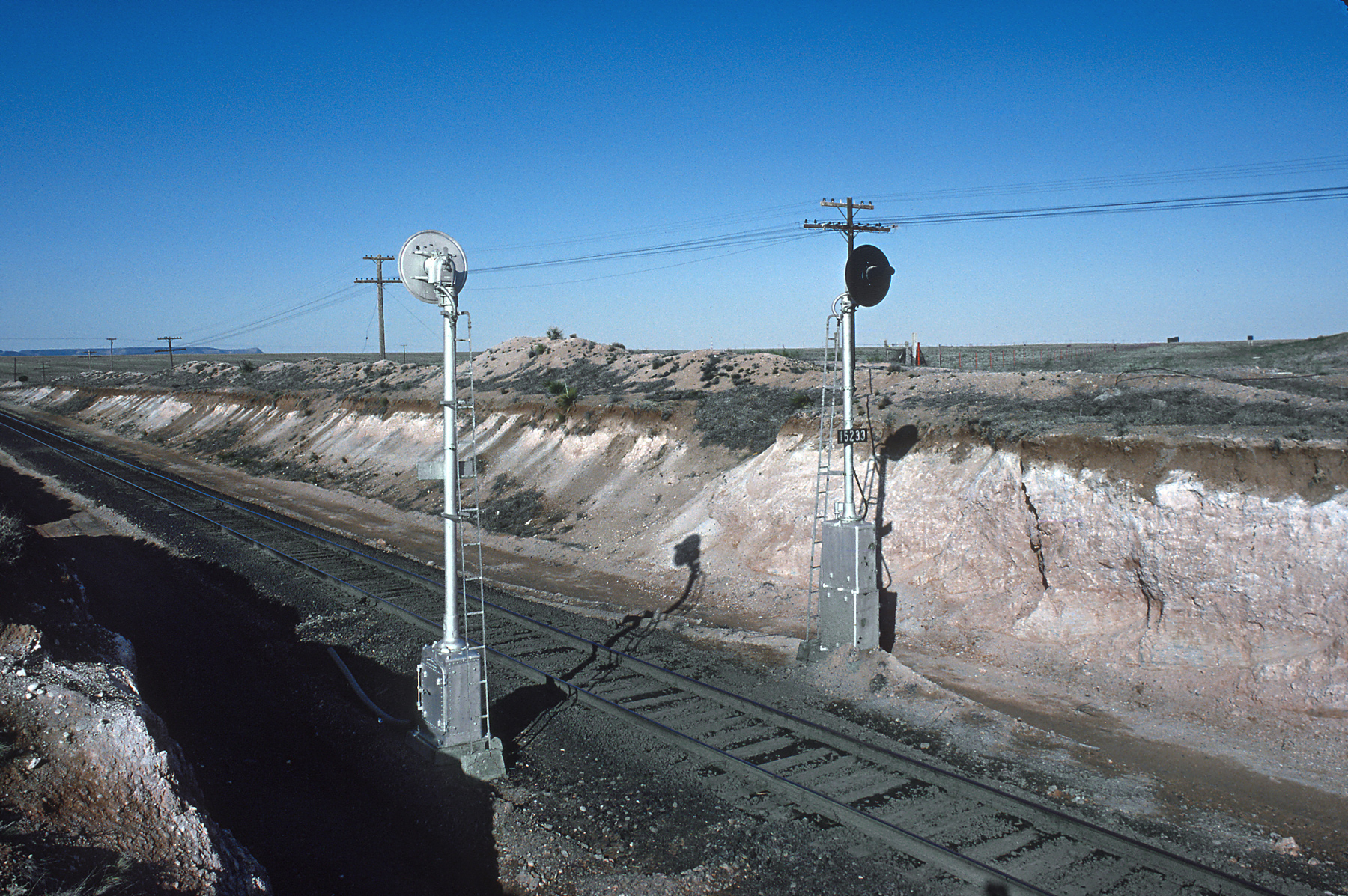 Classic search-light signals protect Southern Pacific's "Golden State Route" near Vaughn, New Mexico in April, 1983. Roger Puta photo.
Classic search-light signals protect Southern Pacific's "Golden State Route" near Vaughn, New Mexico in April, 1983. Roger Puta photo.Signals, How They Function
Railroad signals, historically and even today are a lot more complicated, in terms of their meaning than your basic highway stoplight.
To begin railroad signals serve to functions, protection and control and there are two different types; permissive and absolute.
A permissive signal provides only protection within a given block (meaning a section of signaled track along a rail line having several blocks between Point A and Point B, each protected by a set of signals) while an absolute signal provides both protection and control (i.e., meaning it protects the block while also giving a train ruling instructions).
For instance, when a permissive signal gives a red indication this means stop and proceed while an absolute signal displaying a red indication means stop and do not proceed without further dispatcher instructions.
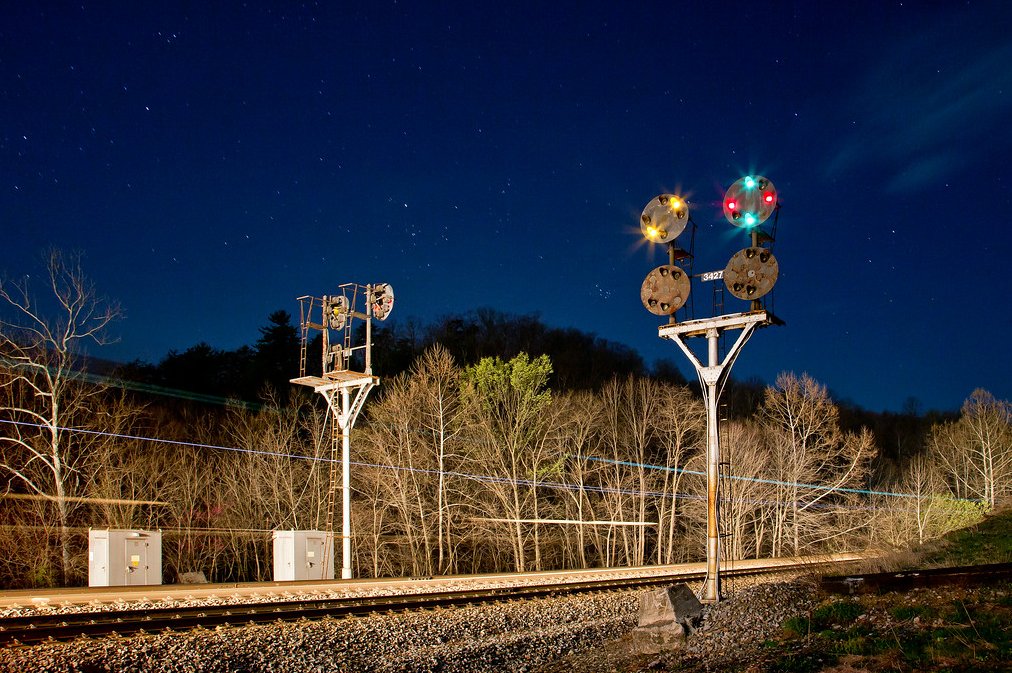 Classic designs like these Norfolk & Western position lights are still active throughout the country but dwindling in numbers. These particular sentinels are found near Willowton, West Virginia along Norfolk Southern. Loyd Lowry photo.
Classic designs like these Norfolk & Western position lights are still active throughout the country but dwindling in numbers. These particular sentinels are found near Willowton, West Virginia along Norfolk Southern. Loyd Lowry photo.After William Robinson's invention of the track circuit in 1872 this gave railroads the ability to signal blocks of rail lines.
The first system was the Automatic Block Signal which used a masted-signal illuminating red, yellow or green to give an indication.
It worked by using low-voltage batteries along the block and as long as the rails were clear of trains a green, proceed indication was shown but when a train entered the block it broke the circuit with both signals then displaying red, or restricted.
Centralized Traffic Control, the most commonly used signaling system today uses both ABS and dispatchers to control the movement of trains as an extra measure of safety.
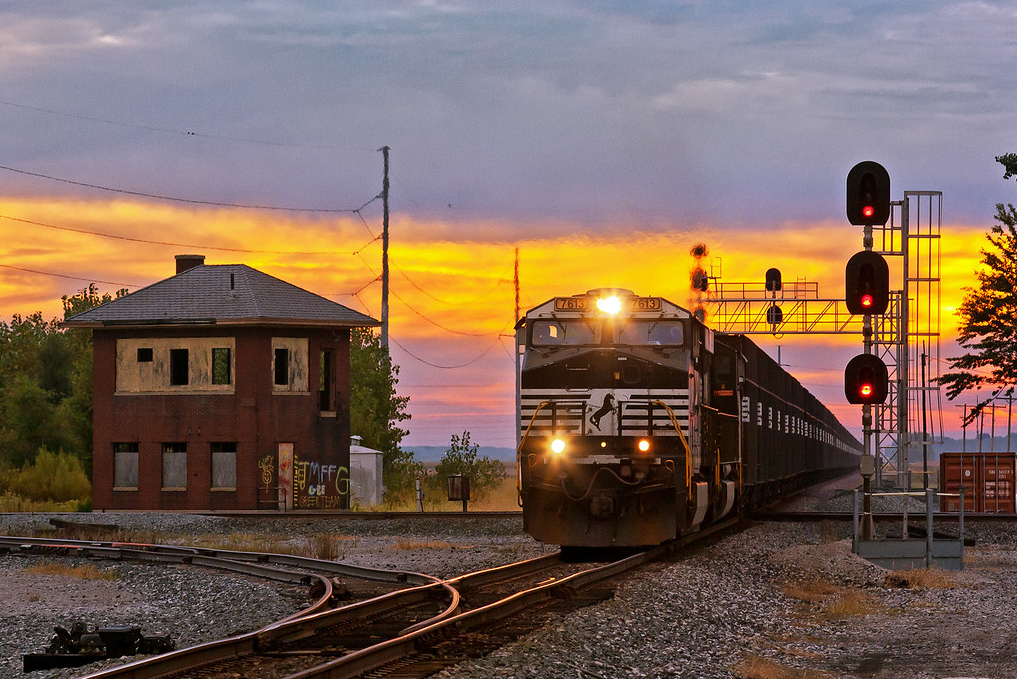 In the modern era Class I's have transitioned to a simplified stop or tri-light type signal, as seen here at Leipsic, Ohio. Pictured is a Norfolk Southern coke train heading westbound past the old XN/RO Tower on the morning of September 18, 2013. The train is running the old Nickel Plate Road and crossing the former Baltimore & Ohio. Loyd Lowry photo.
In the modern era Class I's have transitioned to a simplified stop or tri-light type signal, as seen here at Leipsic, Ohio. Pictured is a Norfolk Southern coke train heading westbound past the old XN/RO Tower on the morning of September 18, 2013. The train is running the old Nickel Plate Road and crossing the former Baltimore & Ohio. Loyd Lowry photo.So, just because a signal may display a green, proceed indication the train cannot move without verbal permission from the dispatcher (unless it has already been given permission beforehand to pass through the upcoming block).
Other signaling systems that were once or are still in use include Direct Traffic Control (DTC), Form D Control System (DCS) and Track Warrrant Control (TWC).
Although it has been mentioned several times above railroad signal displays (green, yellow, and red) mean three things:
- First, aspect is what the signal is displaying such as clear to proceed (green) or restricted to stop (red).
- Second, indication is the instruction the display is giving.
- Third, the name of the display given (i.e., restricted, proceed, diverging clear).
Types
Recent Articles
-
Rio Grande 2-8-2 Locomotives (Class K-28): Specs, Roster, Photos
Apr 14, 25 10:24 PM
Rio Grande's Class K-28 Mikados were its newest narrow-gauge steam locomotives since the Mudhens of the early 1900s. Today, three survive. -
Rio Grande K-27 "Mudhens" (2-8-2): Specs, Roster, Photos
Apr 14, 25 05:40 PM
Rio Grande's Class K-27 of 2-8-2s were more commonly referred to as Mudhens by crews. They were the first to enter service and today two survive. -
C&O 2-10-4 Locomotives: Specs, Roster, Photos
Apr 13, 25 04:07 PM
Chesapeake & Ohio's T-1s included a fleet of forty 2-10-4 "Texas Types" that the railroad used in heavy freight service. None were preserved.


